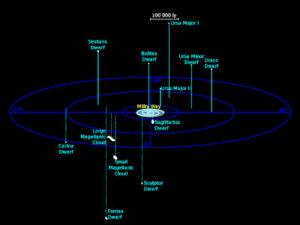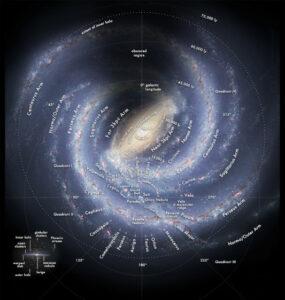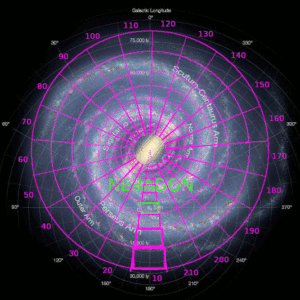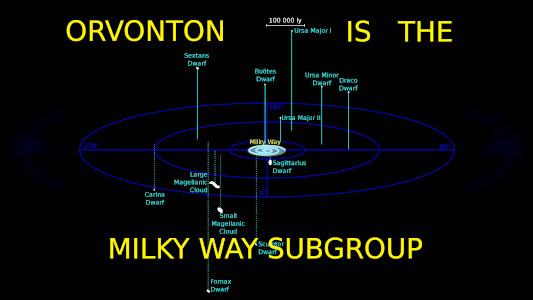Author: Sławomir Żydenko.
Welcome on the blog dedicated to the Urantia Book. First, I would like to apologize to you for such a long break. The material about Orvonton I repeatedly improved and that’s why everything took so long. I do everything in my spare time, and I don’t have much of it. The subject is very complicated and needed to be thought through.
My dear viewers, in the first post of the series there were many mysteries left unsolved, and the purpose of my work is to make the Urantia Book easier to understand. We have so far clarified the terms Urantia and Nebadon. In this post, we’ll talk about Orvonton. This definition should be explained and, if possible, associated with the name currently in use. The present post should therefore be regarded as a continuation of the previous posts, and I therefore encourage everyone to read them as well. The posts are prepared by me in Polish and then translated into English, German, and Russian. If I make a mistake or misunderstand something, please be understanding and feel free to comment on it.
I start with a fragment from the Foreword, which contains a large accumulation of astronomical terms:
“0:0.5 (1.5) Your world, Urantia, is one of many similar inhabited planets which comprise the local universe of Nebadon. This universe, together with similar creations, makes up the superuniverse of Orvonton, from whose capital, Uversa, our commission hails. Orvonton is one of the seven evolutionary superuniverses of time and space which circle the never-beginning, never-ending creation of divine perfection—the central universe of Havona. At the heart of this eternal and central universe is the stationary Isle of Paradise, the geographic center of infinity and the dwelling place of the eternal God.
0:0.6 (1.6) The seven evolving superuniverses in association with the central and divine universe, we commonly refer to as the grand universe; these are the now organized and inhabited creations. They are all a part of the master universe, which also embraces the uninhabited but mobilizing universes of outer space.” The quote is from the website:
https://www.urantia.org/urantia-book-standardized/foreword
Components
Let us now proceed to specify of what components the Orvonton is composed. To begin, let’s deal with the first sentence from the Foreword about Orvonton:
“0:0.5 (1.5) (…) This universe, together with similar creations, makes up the superuniverse of Orvonton, from whose capital, Uversa, our commission hails.”
For the term superuniverse of Orvonton, I have chosen the following quotations from the later parts of the book, which will help to clarify this structure and call it today’s name.
The following quote already explains a lot about the definition of Orvonton:
“15:3.1 (167.17) Practically all of the starry realms visible to the naked eye on Urantia belong to the seventh section of the grand universe, the superuniverse of Orvonton. The vast Milky Way starry system represents the central nucleus of Orvonton, being largely beyond the borders of your local universe. This great aggregation of suns, dark islands of space, double stars, globular clusters, star clouds, spiral and other nebulae, together with myriads of individual planets, forms a watchlike, elongated-circular grouping of about one seventh of the inhabited evolutionary universes.”
https://www.urantia.org/urantia-book-standardized/paper-15-seven-superuniverses
Note, that the sentence “Practically all of the starry realms visible to the naked eye on Urantia belong to the seventh section of the grand universe, the superuniverse of Orvonton.” implies, that there are stars visible to the naked eye that do not belong to Orvonton, but there are few of them. In general, from the quote it follows that Orvonton is our Galaxy, otherwise called the Milky Way, most likely with its closest environment. By this I mean the so-called Milky Way Subgroup, the dwarf galaxies, that are gravitationally connected to the Milky Way.
Please look at the graphics from Wikipedia:

These are dwarf galaxies near the Milky Way. In the case of some of them, it was confirmed that they are in orbit around the Milky Way.
https://en.wikipedia.org/wiki/Satellite_galaxies_of_the_Milky_Way
I will quote just one passage from Paper 12 as confirmation:
“12:2.3 (130.5) In the not-distant future, new telescopes will reveal to the wondering gaze of Urantian astronomers no less than 375 million new galaxies in the remote stretches of outer space. At the same time these more powerful telescopes will disclose that many island universes formerly believed to be in outer space are really a part of the galactic system of Orvonton. The seven superuniverses are still growing; the periphery of each is gradually expanding; new nebulae are constantly being stabilized and organized; and some of the nebulae which Urantian astronomers regard as extragalactic are actually on the fringe of Orvonton and are traveling along with us.”
https://www.urantia.org/urantia-book-standardized/paper-12-universe-universes
Please read one more quote from Paper 15, it says explicitly that Orvonton is our Galaxy:
“15:3.4 (167.20) Of the ten major divisions of Orvonton, eight have been roughly identified by Urantian astronomers. The other two are difficult of separate recognition because you are obliged to view these phenomena from the inside. If you could look upon the superuniverse of Orvonton from a position far-distant in space, you would immediately recognize the ten major sectors of the seventh galaxy.”
https://www.urantia.org/urantia-book-standardized/paper-15-seven-superuniverses
From the above quotations, in my opinion, we can conclude that the core of Orvonton is indeed the Milky Way, and it is this, that mainly inhabited is. But orbiting around the Milky Way smaller astronomical units, referred to as islands universes and nebulae, also belong to Orvonton.
Number of stars
Now it is worth considering the size of the superuniverse of Orvonton. More specifically, I’m talking about the number of stars.
Passage from Paper 15.:
“15:6.10 (172.12) The superuniverse of Orvonton is illuminated and warmed by more than ten trillion blazing suns. These suns are the stars of your observable astronomic system. More than two trillion are too distant and too small ever to be seen from Urantia.”
https://www.urantia.org/urantia-book-standardized/paper-15-seven-superuniverses
Ten trillion stars is a lot, isn’t it? How many stars are there in the Milky Way, according to Wikipedia? Let’s read a passage:
“The Milky Way is a barred spiral galaxy with an estimated visible diameter of 100,000–200,000 light-years. Recent simulations suggest that a dark matter area, also containing some visible stars, may extend up to a diameter of almost 2 million light-years. The Milky Way has several satellite galaxies and is part of the Local Group of galaxies, which form part of the Virgo Supercluster, which is itself a component of the Laniakea Supercluster.
It is estimated to contain 100–400 billion stars and at least that number of planets.”
https://en.wikipedia.org/wiki/Milky_Way
Well, here’s the problem. The Urantia Book speaks of over ten trillion “blazing suns” and Wikipedia says one hundred to four hundred billion stars.
Please note that we are talking here about the estimated number of stars. If the number of stars is estimated, it means that it is not counted. So no one knows exactly how many stars there are. It is also unclear where the boundaries of the Milky Way are. Determining the diameter of the Galaxy from one hundred to two hundred thousand light years, and perhaps even up to two million light years is, to put it mildly, imprecise. Perhaps the same precision applies to estimating the number of stars? Perhaps numerous stars at the edge of the disk were not included in the Milky Way, but actually belong to it? Orvonton is most probably the Milky Way with its closest environment. The inaccuracy is probably also due to the situation described in the Urantia Book, that the stars beyond the centre of the Galaxy can not be observed from the inside of its disk, where we are. The stars inside the centre of the disk are also not observable. It is therefore not easy to estimate the number of stars inside the centre of the disk if it cannot be studied. We just don’t have the reliable sample that we had when we calculated the size of the Nebadon. The centre of the galaxy is simply not good enough known.
Please look on the graphics from Wikipedia:

Galaxy with the avoid zone marked. The nucleus of the Galaxy can be compared to an impenetrable cloud. If you cannot see what is behind the cloud, you cannot see what is inside the cloud either.
https://commons.wikimedia.org/wiki/File:Milky_way_map.png
Author: Pablo Carlos Budassi.
As a solution to this problem, there are several possibilities that come to my mind.
1. First, The Urantia Book is wrong – it is possible. Possibly there were some mistakes or someone thought of something. But why do so many of the other facts described in the Book agree with reality?
2. Second, scientists are wrong — it is possible, we are talking about estimates. Part of the Galaxy beyond its centre is invisible. The centre itself is also difficult to study. Stars simply cannot be counted. There are many so-called red dwarfs in space. These are stars with low luminosity and small size. Their number can be strongly underestimated. Red dwarfs are the most numerous. From sixty of the nearest stars, fifty are red dwarfs and none of them are visible to the naked eye. The centre of the galaxy can not be studied enough to know how many objects as small as red dwarfs are there.
https://en.wikipedia.org/wiki/Red_dwarf
The entire procedure for estimating the number of stars is described in detail in an article on space.com. No one counts the stars individually, but they are counted as a whole. First, the mass of the entire galaxy is calculated based on the rotation. Then the components of the galaxy are determined. The biggest problem is to assess how much mass the stars have in relation to the other components of the galaxy. It is clear from the article that nothing is simple or obvious here, and the results cannot be checked anyway.
https://www.space.com/25959-how-many-stars-are-in-the-milky-way.html
3. Third, no one is wrong. One and the other are right, but in each source it is said about something else. Where does this idea come from? For example, it is known that there are many of red and brown dwarf type stars in the cosmos. Perhaps they do not emit enough light to be considered stars? They may be so-called sub-stellar objects, unable to fuse hydrogen into helium, so they are not included in the estimates. However, red and brown dwarfs can emit enough light and heat to support life in their environment. A quote from the English Wikipedia about red dwarfs:
“Many of the coolest, lowest mass M dwarfs are expected to be brown dwarfs, not true stars, and so those would be excluded from any definition of red dwarf.”
https://en.wikipedia.org/wiki/Brown_dwarf
4. Fourth there’s also the possibility that Orvonton is a term for more galaxies, not just the Milky Way. However, from the following parts of the text, it is quite clear that Orvonton is precisely the galactic system of the Milky Way. The problem is also not solved by counting stars from the Milky Way’s satellite galaxies, as it will still be far too few.
Summary
To sum up, I personally think the most likely option is number 2, which is a huge underestimation of the number of stars in the Milky Way. And to a certain extent, I also think that possibility number 3, which is that “blazing suns” are objects that scientists do not recognize as stars.
In general, Wikipedia gives neither confirmation nor denial of the Urantia Book data regarding the number of stars in Orvonton. The estimated number of stars from zones of the Galaxy that have not been fully explored cannot be taken as evidence. Of course, this is not a scientific conclusion, but a logical conclusion. If I don’t have all the data, I might be wrong.
Experiment
Let us perform an experiment. When I was a child I used to play at calculating the huge flocks of birds flying high in the sky. I was calculating how many space were occupied by ten birds and then I was multiplying this sector by ten. This gave a sector with a hundred birds. And then I visually divided the flock into the number of sectors of one hundred birds each one and so I obtained the approximate size of the flock. Let us apply the above method, to calculate the stars in the disk of our Galaxy.
Our Galaxy is a large nucleus and a disk. We can add to this possibly dwarf satellite galaxies orbiting around. According to the laws of physics, the most matter and therefore stars should be in the nucleus, less in the disk and the least in the satellite galaxies. The principle is simple – the further away from the centre, the less matter is held in orbit.
What we are interested in is the actual number of stars. The problem is that the nucleus and the part of the disk behind the nucleus are so difficult to observe that it is not known exactly how many stars there are. Let us assume that we do not trust any of the sources. We don’t know if the Urantia Book is correct and Orvonton, the whole Galaxy, has 10,000,000,000,000 (ten trillion) stars. We also do not know if the information on Wikipedia about the number of stars in the Galaxy is true. Their number has been estimated, so it could also have been misestimated. Let us also assume that my calculations of the size of Nebadon from the previous episode are correct. Let me just remind you that I based my calculations on data from the Wikipedia page on the closest stars to Earth. These data are not estimated but based on observations, so they are reliable. They only have the disadvantage that the sample taken for the calculation is relatively small and may not reflect the true density for Nebadon as a whole. The actual volume of Nebadon may therefore be different, and a small error multiplied many times will give a large error. This is a bit risky, but I don’t have better data to carry out my experiment.
Nebadon contains 100,000,000 (one hundred million) stars and occupies 24,000,000,000 (twenty-four billion) cubic light years. Based on the calculated size of Nebadon and on the principle that the closer to the centre, the more matter, we can calculate the approximate number of stars in the disk. What is left falls into the nucleus. The closer to the centre, the sectors are smaller and the number of stars in each sector remains the same, that is 100,000,000 (one hundred million). We therefore apply the principle of increasing density towards the centre. Dwarf satellite galaxies orbiting the Galaxy are ignored for the time being.
The numbers at our disposal are so large that it is hard to imagine them. We will, by the way, convert the absolute numbers into percentages.
Take a look at the graphic below.

I have left the galactic nucleus as an unknown zone, where conditions may be different, not comparable to our environment in the galactic disk. In contrast, I treated the invisible side of the disk in the same way as our surroundings. The rectangle symbolising Nebadon is proportionally reduced towards the centre, while towards the outside it is proportionally increased.
The result of the experiment is 210 sectors in the disk, corresponding numerically to Nebadon, that is
100,000,000 stars * 210 = 21,000,000,000 stars
~ 20,000,000,000
There would be 21 billion stars in the disk alone according to this calculation. To make further calculations easier, let’s round this sum to whole tens, that is 20 billion. Let us compare this number with the estimated number of stars in the entire Galaxy. According to Wikipedia, this is between 100 and 400 billion. After subtracting the stars from the disk, it comes out that there would be between 80 billion and 380 billion stars in the vast nucleus of the Galaxy, that is 80 to 95% of the stars.
In the first case, that is 80% of the stars per galactic nucleus seems to be low. The second result, that is 95% already seems more likely to me.
Let’s look at the equations. The result is the answer to the question of how many percent are the stars in the disk in relation to the total number of stars in the Milky Way.
Assuming that the Milky Way consists of 100 billion stars:
100,000,000,000 — 100%
20,000,000,000 — x
x = 100% * 20,000,000,000 / 100,000,000,000 = 2,000,000,000,000% / 100,000,000,000 = 20%
And assuming that the Milky Way consists of 400 billion stars:
400,000,000,000 — 100%
20,000,000,000 — x
x = 100% * 20,000,000,000 / 400,000,000,000 = 2,000,000,000,000% / 400,000,000,000 = 5%
According to the Urantia Book, on the other hand, there are 10 trillion stars in the whole of Orvonton. 20 billion of this is 0.2%, that means that the galactic nucleus would account for 99.8% of the stars.
Let’s take another look at this calculation assuming that overall the Milky Way contains 10 trillion stars:
10,000,000,000,000 — 100%
20,000,000,000 — x
x = 100% * 20,000,000,000 / 10,000,000,000,000 = 2,000,000,000,000% / 10,000,000,000,000 = 0.2%
Personally, this result seems the most likely to me. Our Galaxy, in that case, is mainly the nucleus and the disk is only like a veil on the bride’s head.
Let us compare the result to the Solar System. Here the Sun is the largest and the satellites are only a tiny fraction of the total mass of the System. The Wikipedia page tells us that the Sun accounts for 99.86% of the mass of the entire Solar System. The result is almost the same as assuming that the Orvonton, that is the Milky Way, together with its dwarf satellite galaxies, is 10 trillion stars. Perhaps this is a coincidence, or perhaps there is a similar ratio in ever larger structures when it comes to the mass of the nucleus to its satellites. In any case, the mass of the satellites is calculated in fractions of a percent, not percentages.
The galactic nucleus is truly gigantic. In the sky, it has the diameter of the Sun or the full Moon, and it is, after all, 25,000 light years away. In comparison, the Sun is only 8 light minutes away from the Earth.
https://www.astronomy.ohio-state.edu/ryden.1/ast162_7/notes31.html
In my opinion, the experiment is an argument that the data in the Urantia Book are true.
The result of the experiment is interesting, isn’t it? Is that a proof? Definitely not, but it makes you think! How about that? Write in the comment.
https://en.wikipedia.org/wiki/Solar_System
Diameter
There are two interesting points in the above quote from Wikipedia. The first mentions satellite galaxies of the Milky Way and the second mentions a dark matter halo two million light years in diameter. It is known that a dark matter halo is an area in which a galaxy affects the cosmic bodies within it. These are the satellite galaxies mentioned. Together with the Milky Way, they form an astronomical unit called the Milky Way Subgroup. This looks very similar to what we have read about in the quote from Paper 12 of the Urantia Book a few moments earlier. We have read about island universes and nebulae that, I quote, “…are actually on the fringe of Orvonton and are traveling along with us.”
https://en.wikipedia.org/wiki/Dark_matter_halo
Orvonton is a galactic system, not just a galactic disk. It can be compared to the Solar System — It consists of the Sun and its satellites contained within its gravitational influence.
Definition
Finally, I’ll give you the definition of the superuniverse of Orvonton. It basically follows directly from the rest of the Book, and there is not much choice here. The superuniverse of Orvonton is the Milky Way together with the dwarf satellite galaxies within its gravitational influence. The most appropriate name for the Orvonton, which is currently used, is the name of the astronomical unit called the Milky Way Subgroup. The diameter of Orvonton most likely corresponds to the diameter of the dark matter halo around the Milky Way, and it has, according to Wikipedia, two million light years. The Milky Way, on the other hand, is only the “central nucleus” of Orvonton, as we read in one of the quotes.
Final words
My dear viewers, at this point I will end this post. I have material prepared for the next post. Next time we’ll talk about the Uversa. In the meantime, I say goodbye to you. Please write in the comments what you think about this.
Link to the first part:
https://urantia.online/en/god-the-universe-and-other-planets-the-urantia-book-foreword_1/
Link to the second part:
https://urantia.online/en/urantia-is-earth-nebadon-is-fragment-of-the-milky-way/
Link to the video:
Support:
https://urantia.online/en/support/
Facebook:
https://www.facebook.com/slawomir.zydenko/
Source of thumbnail graphics:
https://en.wikipedia.org/wiki/Satellite_galaxies_of_the_Milky_Way

